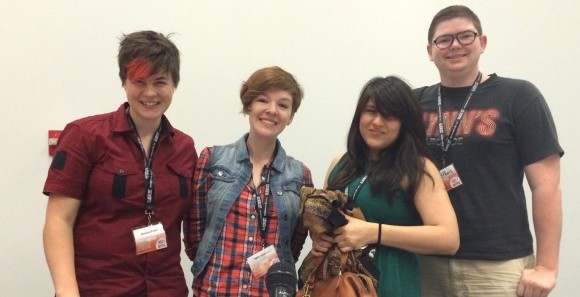On Easter Sunday at WonderCon 2014, BOOM! Studios hosted a panel on “Redefining All-Ages Comics.” The panel included Senior Editor Shannon Watters, writer/artist Noelle Stevenson (who co-created Lumberjanes), and the co-writers of Bee and PuppyCat Natasha Allegri and Garrett Jackson.
Watters brought up that for some time now, certain readers and reviewers will describe a story as “all-ages” and then quickly add, “but don’t worry, it’s not just for kids!” As Watters pointed out, such a statement should be unnecessary if the story is described as being for all ages. Stevenson remarked, “Comics are in this weird place right now… Everyone’s trying to, I think, prove wrong this really outdated notion that comics that comics are [for kids]. Oooh, Batman’s even more dark and gritty and he’s so full of pain!… There’s stubble everywhere! We’re not children! This is an adult book.”
Watters asked the panel how much of what they write is really for kids or for themselves. Allegri answered, “I write what I like… And kids like innocent and funny, but also stories that are edgy.” The Harry Potter series was then brought up as an example of this, where mature themes such as having your parents die, being abused, or simply feeling lonely were all approached in accessible ways. Stevenson pointed out that Indiana Jones, Star Wars, and The NeverEnding Story as movies that involve violence and mature themes but were approached in an all-ages manner, where the audience feels the gravity of the events without the camera needing to zoom in on gore.
Allegri added, “There’s a difference between using violence as part of the story and the shock value. Japanese children shows have nudity, full nudity sometimes… and it’s not sexualized… And the violence, there’s a difference between showing someone passing away and exploiting it.”
Watters referred to emotional moments of loss in a good story as a moment of “glad-sad,” where the reader or viewer is in mourning but is also glad to feel such a valid connection to the drama. She added that for kids this can be a learning experience that prepares them for similar moments later in life, even if it’s on a smaller scale. “Sometimes bad things happen to kids and kids need to see that you can rebound… Harry Potter is an abused kid. And he becomes a very powerful figure.”
On the process of writing, Noelle Stevenson said that she had been used to writing solo at first, but writing in a team with Lumberjanes co-creator Grace Ellis was a rewarding experience with different challenges. “Not every idea you have has to be golden. You can have a bad idea and your partner will help turn it into a good idea… Working in a team, it’s more about trying to find that middle ground between your two voices.” Similarly, Jackson said that he benefited from having Allegri as a co-writer. “If you are writing your own thing you can get kind of tunnel visioned on it, and if you have another person that you’re writing with, they can kind of keep you balanced.”
The panel brought up that kids and adults are scared by different things and that some stories intended for children seem far scarier and more disturbing when the reader is older and has a different context. Stevenson said that it was important in writing scary children stories to keep some idea that the danger could be escaped in the end or that the threat could be revealed as false. Scooby-Doo and Winnie the Pooh were brought up as examples of this type of storytelling, where kids could see the protagonists be frightened, only to later realize they had the power to get through or overcome the scary situations.
Watters said the key to successful all-ages comics, like any story, is earnest storytelling rather than something that talks down to readers or preaches to them. “If you portray those emotions honestly, you’re good.” She also remarked, “It’s kind of a bummer that earnest storytelling is kind of dismissed… I think that’s so funny. I think not talking down to people is so important… It’s what separates great all-ages content from really mediocre content.”
Stevenson added that she believes earnest storytelling is rising in comedy. “Ten years ago it was very ironic, very sarcastic, a lot of snark… And now you’ve got this very sincere but hysterical humor style… A lot of people went to see The Lego Movie, and it wasn’t just kids, because it was [a story] that a lot of people cared about.” In contrast, she then brought up the comic book and movie franchise Kick-Ass. “It kind of had a lot of spite towards its origins… Superhero stories were very full of joy to begin with. They were very straightforward. And then it was kind of like [Kick-Ass] said, ‘We’re embarrassed by that now.’… It felt mean.”
Watters: “The greatest thing about superheroes is moralism… Superman does not have to be good. He is the strongest, most powerful being… But Superman’s humanity, that makes him good… That’s what I feel like superhero stories and all-ages stories do really, really well. It shows that kind of innate goodness of someone choosing to be good, even when it’s hard.”
Are you following The Mary Sue on Twitter, Facebook, Tumblr, Pinterest, & Google +?









Published: Apr 29, 2014 02:00 pm